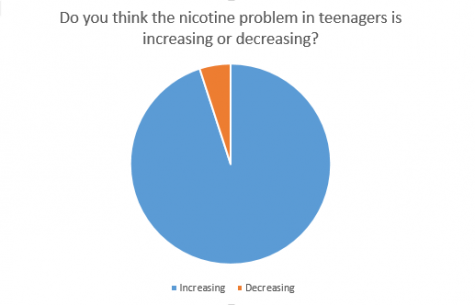Nicotine Addiction in Teenagers
The use of cigarettes in high school students has reduced rapidly, reaching the lowest levels in 24 years in 2018. Although many people would like to believe this decrease is a result of educating students about the effects of these chemicals on their bodies, the more accurate reason is less noble. According to the National Institute on Drug Abuse, as the use of tobacco products have declined, the sales of smoke free products, such as e-cigarettes, have risen significantly. PCNN conducted a poll, asking Panther Creek students if they believed the nicotine problem in teenagers was increasing or decreasing. The results were nearly unanimous, all but one student agreeing that the issue was increasing.
Products that electronically deliver nicotine have become more common among adolescents than any other age group. PCNN asked students why they thought that these devices are so attractive to teenagers. Senior Lauryn Mulder responded by saying, “I feel like it’s more common just because people think its cool,” continuing on to say students start using the products socially, and gradually become addicted to the chemicals.
When asked about the nicotine issue among high school students, senior Karisma Kak expressed her belief that the problem has been around for too long for a single solution to be able to solve it. “I think people should just stop using [e-cigarettes] as much,” she said, when asked for a possible resolution. Another commonly advocated solution is to raise the age minimum from 18 to 21.
Many groups have been formed across the United States to try and reduce the use of nicotine and tobacco products. One such organization, Tobacco Free Kids, aims to prevent the spread of use of these products in teenagers by spreading awareness of the consequences they bring. In an article titled, “The Path to Tobacco Addiction Starts at Very Young Ages,” the institution explains that, “nicotine is a highly addictive drug; and adolescents, who are still going through critical periods of growth and development, are particularly vulnerable to its effects.”
In the United States, six states and over 350 localities have raised the legal age for tobacco purchases by three years. Lots of these organizations are continuing to campaign for the age restriction until the whole country is under the new law.
On the other side of the argument, many large tobacco business, such as Philip Morris International Inc., have expressed their opposition for a new country-wide age minimum. In a 1986 report, the company stated that, “raising the legal minimum age for cigarette purchases to 21 could gut our key young adult market (17-20) where we sell about 25 billion cigarettes and enjoy a 70 percent market share.” Financially, a higher age limit will hurt tobacco companies across the United States.
In the end, the use of nicotine devices by teenagers will not be stopped overnight, nor by a single law. What will help, however, is schools educating students about the dangers of the products. Teaching the students about the consequences will allow them adolescents to make safer decisions in the future.










